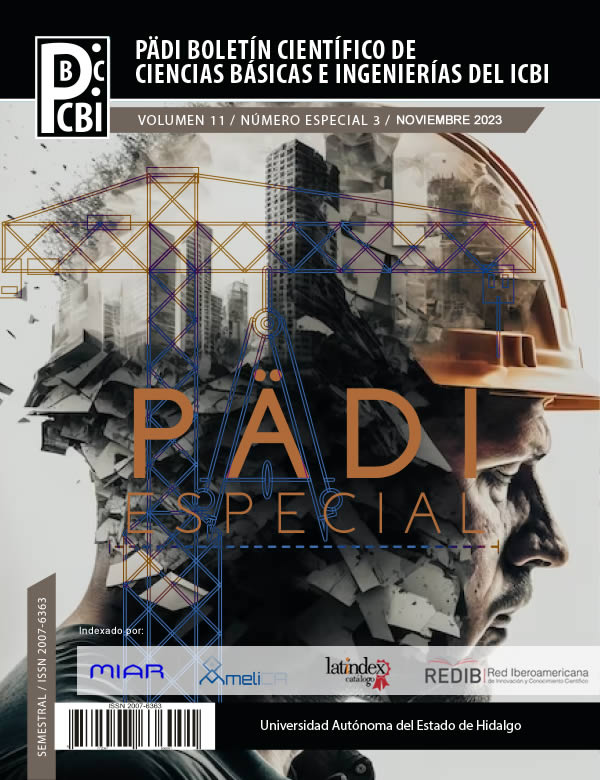Design of solar protection elements for glazed facades as an improvement to thermal comfort: case study in the city of Mexicali, Baja California
Abstract
Cities with a very dry hot climate such as Mexicali, Baja California, reach very high temperatures in summer and very low temperatures in winter, which demands the excessive use of air conditioning to keep the spaces comfortable. The purpose of this study is to evaluate the design proposal of a solar protection element based on the sun trajectory to be applied in that city, in order to improve the thermal comfort conditions inside the spaces and thus, allow passive air conditioning and obtain thermal load reductions that provide an energy benefit. A south-oriented base model was used, under a quantitative methodological scheme with cause-effect analysis, by means of simulation through EnergyPlus, which emphasizes the use of models and analogies. Likewise, the analysis period was carried out for one year, comparing the results with and without the solar protection elements. The results show that the application of the solar protection elements allows a decrease in the operating temperature inside the base model and a greater number of hours of thermal comfort, as well as a decrease in energy consumption.
Downloads
References
Aguirre, M. (2022). What is a weather file and which ones do we reference.
ASHRAE and the American National Standards Institute. (2021). ANSI/ASHRAE Addendum a to ANSI/ASHRAE Standard 169-2020.
ASHRAE. (2019). Standard 90.1-2019 Energy Standard for Buildings Except
Auliciems, A., Szokolay, S. (2007) Thermal Comfort. 2nd Revised Edition, Brisbane, PLEA: Passive and Low Energy Architecture International in association with Department of Architecture, The University of Queensland.
Buen, O. (2016). Conuee y la normalización para la eficiencia energética. CONUEE.
Calderón, F. (2019). Evaluación del mejoramiento del confort térmico con la incorporación de materiales sostenibles en viviendas en autoconstrucción en bosa, Bogotá. Rev. hábitat sustentable vol.9 no.2.
Comisión Nacional De Vivienda. (2013). Proyecto Piloto de Aislamiento Térmico para viviendas en Mexicali. Gobierno de México.
Chi, D. (2021). Iluminación natural a través de ventanas. Universidad de las Américas Puebla - UDLAP. https://altexto.mx/iluminacion-natural-a-traves-de-ventanas-dg5ue.html
CONAFOVI. (2006). Guía para el uso eficiente de la energía en la vivienda.
CONAGUA. (2021). Reporte del clima en México: reporte anual 2021.
Design Builder, 2023. EnergyPlus Weather File (EPW) Format. Climatic Analytics. https://designbuilder.co.uk/cahelp/Content/EnergyPlusWeatherFileFormat.htm
Echeverri, P. (2020). Importancia de la trayectoria solar en la arquitectura. Echeverrimontes.
EnergyPlus (2023). Sitio oficial de EnergyPlus. https://energyplus.net/
Fuentes Freixanet V.A. (2008). Arquitectura bioclimática. Ciudad de México DF, editorial: Universidad Autónoma Metropolitana - UAM. p. 4
García, E. (2004). Modificaciones al sistema de clasificación climática de Koppen. UNAM.
Gobierno de Navarra (s.f.). Meteorología y climatología de Navarra. Navarra.es.
Guadarrama, C. (2017). Luz natural en la arquitectura. Aportaciones científicas, tecnológicas y de diseño. Universidad Nacional Autónoma de México.
Hidden Architecture. (2021). Ungreen: Brise Soleil.
http://help.covetool.com/en/articles/2495609-weather-file
INEGI (2010). Compendio de información geográfica municipal 2010, Mexicali, Baja California. Instituto nacional de estadística y geografía.
Koeppen Whilhelm (1948). Climatología, con estudio de los climas de la tierra. Ciudad de México DF: Fondo de Cultura Económica - CFE.
Low-Rise Residential Buildings.
Martín-Monroy Manuel (2007). Manual de iluminación. Manuales de Diseño ICARO, Ayuntamiento y Universidad de las Palmas de Gran Canaria. pags. 26 - 61.
Norma Oficial Mexicana - NOM (2014). Eficiencia energética en sistemas de alumbrado en edificios no residenciales. (NOM-007-ENER-2014).
Norma Oficial Mexicana - NOM (2001). Eficiencia energética en edificaciones, envolvente de edificios no residenciales. (NOM-008-ENER-2001).
Norma Oficial Mexicana - NOM (2011). Eficiencia energética en edificaciones, envolvente de edificios para uso habitacional. (NOM_020_ENER_2011).
Norma Oficial Mexicana - NOM (2013). Edificación sustentable criterios y requerimientos ambientales mínimos. NMX-AA-164-SCFI-2013, p. 16.
Norma Oficial Mexicana - NOM (2008). Condiciones de iluminación en los centros de trabajo. (NOM-025-STPS-2008)
Pabón-Vázquez K. (2022). Soluciones para el Sobrecalentamiento de Edificios en Zonas Urbanas en Puerto Rico. Tesis de Maestría en Arquitectura, Universidad de Puerto Rico - UPR, p. 6 https://repositorio.upr.edu/bitstream/handle/11721/3081/Trabajo%20de%20Fin%20de%20Carrera%20%28K.Pab%c3%b3n%20V%c3%a1zquez%29%20.pdf?sequence=1&isAllowed=y
Peligros hidrometeorológicos. (s.f). Atlas de riesgos del municipio de Mexicali. Gobierno de Mexicali.
Radiografía de la energía en baja california. (s.f). El colegio de la frontera norte. Centros CONACYT.
Rhinoceros. (2023). Rhinoceros. https://www.rhino3d.com/es/
Ruiz, I. (2012). Bioclimatismo en la arquitectura de Le Corbusier: El Palacio de los Hilanderos.
Uppunda, S. (2022). 10 Grasshopper Plugins Trending In The AEC Industry. Parametric architecture. https://parametric-architecture.com/10-grasshopper-plugins-trending-in-the-aec-industry/
Vega, M. (2015). Análisis del desempeño y funcionamiento de sistemas fotovoltaicos instalados en Mexicali, Baja California. UABC.
Wright Jaime (2006). Cálculo espectral de la irradiación directa, difusa y global en Heredia, Costa Rica. Universidad Nacional Heredia - UNH: Redalyc p. 3 http://www.redalyc.org/articulo.oa?id=475948929009
Copyright (c) 2023 Gerardo Santamaría-Villa, Carlos Alfredo Bigurra-Alzati, Aníbal Luna-León

This work is licensed under a Creative Commons Attribution-NonCommercial-NoDerivatives 4.0 International License.













